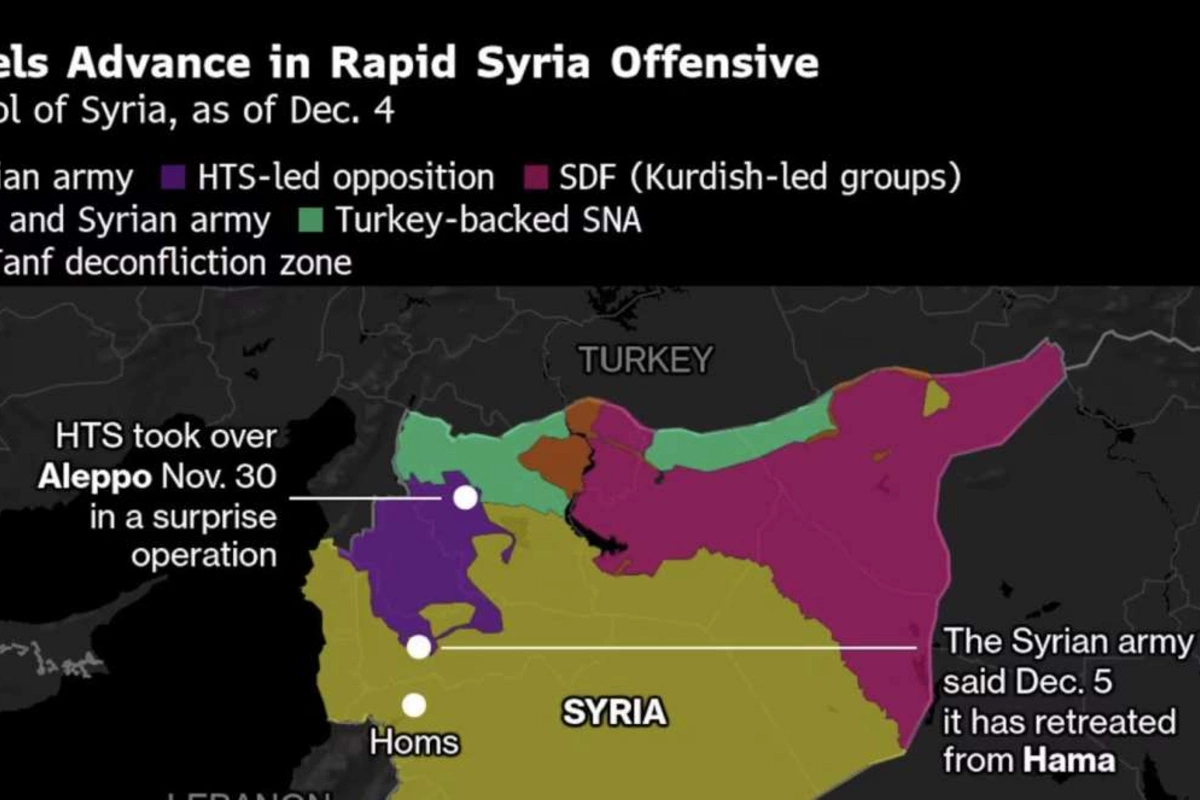
The military resources of both Tehran and Moscow are stretched by conflicts in the Middle East and Ukraine. So far, Assad has Russia’s airstrikes on rebel positions and a tepid promise from Iran to consider requests for troops, yet not the emphatic backing he’s counting on to halt the onslaught.
Photo: www.bnnbloomberg.ca
Syrian President Bashar Al-Assad is growing increasingly reliant on Russian and Iranian support as rebel forces close in on the strategically vital city of Homs, hoping his key allies will intervene as they did in 2015, when he was on the verge of losing power, The Caspian Post reports citing BNN Bloomberg.
But almost a decade later, their support is far from certain. The military resources of both Tehran and Moscow are stretched by conflicts in the Middle East and Ukraine. So far, Assad has Russia’s airstrikes on rebel positions and a tepid promise from Iran to consider requests for troops, yet not the emphatic backing he’s counting on to halt the onslaught.
After capturing Hama on Thursday, the rebels are now mere kilometers from Homs, the last major city on their path south to the capital, Damascus. Taking Homs could close the land route between Assad’s government and his Alawite sect’s Mediterranean strongholds, which are also home to a Russian naval base. That would further undermine his chances of holding onto power.
“Assad’s future has never looked more fragile than it does today, and for now, Russia doesn’t seem able — or perhaps even willing — to save him,” said Charles Lister, director of the Syria and countering terrorism and extremism programs at the Washington-based Middle East Institute. “Much of the Homs countryside remains tacitly supportive of the opposition and that will help significantly in clearing an emboldened path to the city itself.”
The response by Russian President Vladimir Putin, who helped turn the tide of Syria’s enduring civil war in Assad’s favor nine years ago, has been muted. Moscow has used warplanes to strike rebel positions during the rapid advance, but there’s been no clear pronouncement of support or deployment of forces nearly three years into its invasion of Ukraine.
Iran already has a military presence in Homs and other parts of Syria. On Wednesday, it said it would weigh sending more troops if requested by Assad. But that’s weak assurance for a key pillar of Tehran’s so-called axis of resistance of states and groups hostile to the West, and may have been influenced by direct and indirect clashes with US-backed Israel.
Iran’s network of allied militias may be Assad’s best hope for ground reinforcements to shore up his crumbling army. Yet, the most powerful of them, Lebanon’s Hezbollah, has been degraded by a major Israeli offensive and last week agreed to a ceasefire. That leaves Syria looking over its eastern border to Iraq-based groups for support.
“Iran retains large and well-equipped militias there that have been deployed to support Assad in the past,” said Gregory Brew, a senior analyst for Iran and energy at the Eurasia Group. The issue is that the Iraqi government is reticent to embroil Iraq in the Syrian crisis, he said.
The Syria rebels are led by Hayat Tahrir al-Sham, a former affiliate of al-Qaeda that’s designated a terrorist organization by the US and others. Their leader, Abu Mohammed Al Joulani, on Thursday called on Baghdad not to let Iraqi militias from the Iran-backed Popular Mobilization Forces intervene in Syria. Influential Shiite cleric Moqtada al-Sadr also called on the Iraqi government to avoid pulling Baghdad into a wider Syria conflict.
Still, some militants based in the country have crossed the border to back the government’s counteroffensive, the Associated Press reported this week.
Iraqi Foreign Minister Fuad Hussein, in a meeting with Syrian counterpart Bassam Sabbagh, expressed “deep concern” about the developments, according to a statement by the Iraqi Foreign Ministry on Friday. Tehran’s top diplomat has flown to Iraq for talks on the crisis, according to a ministry statement.
The rebel forces have surprised many by the speed of their advance since capturing Aleppo last week. Their successful toppling of Assad would create more turmoil in a region that’s been upended by the ongoing Israel-Hamas war in Gaza and associated conflicts.
The foreign ministers of Iran, Russia, and Turkey — guarantor states of the Astana peace process, which helped deescalate the civil war until the rebels moved on Aleppo — are expected to meet in Qatar as early as this weekend to discuss the crisis.
Rifts between the three were laid bare when Iranian Foreign Minister Abbas Araghchi visited Ankara this week. Between handshakes and smiles with his Turkish counterpart Hakan Fidan, Araghchi denounced the renewed violence as an Israeli plot. Fidan argued it couldn’t be blamed on foreign interference, calling on Assad to reach a settlement with the rebels, some of whom are backed by Turkey.
Turkish President Recep Tayyip Erdogan said he hopes the opposition’s “march in Syria continues safe and sound,” the state-run Anadolu Agency reported. He said he invited Assad to meet for talks on Syria’s future but “didn’t receive a positive response.”
While foreign diplomats ponder what to do, the fall of Homs appears to be only a matter of time, according to Serhat Erkmen, director of Pros&Cons Security and Risk Analysis Center based in Ankara. Thousands of people have fled the city in anticipation of its capture, according to local reports.
“Homs is much more critical than Hama and its capture could seriously threaten Assad’s rule,” he said. “If the Syrian regime is determined to defend it, the fighting could take about a week. But if the morale among their ranks is low, then the rebels could capture it in about two days.”
Share on social media